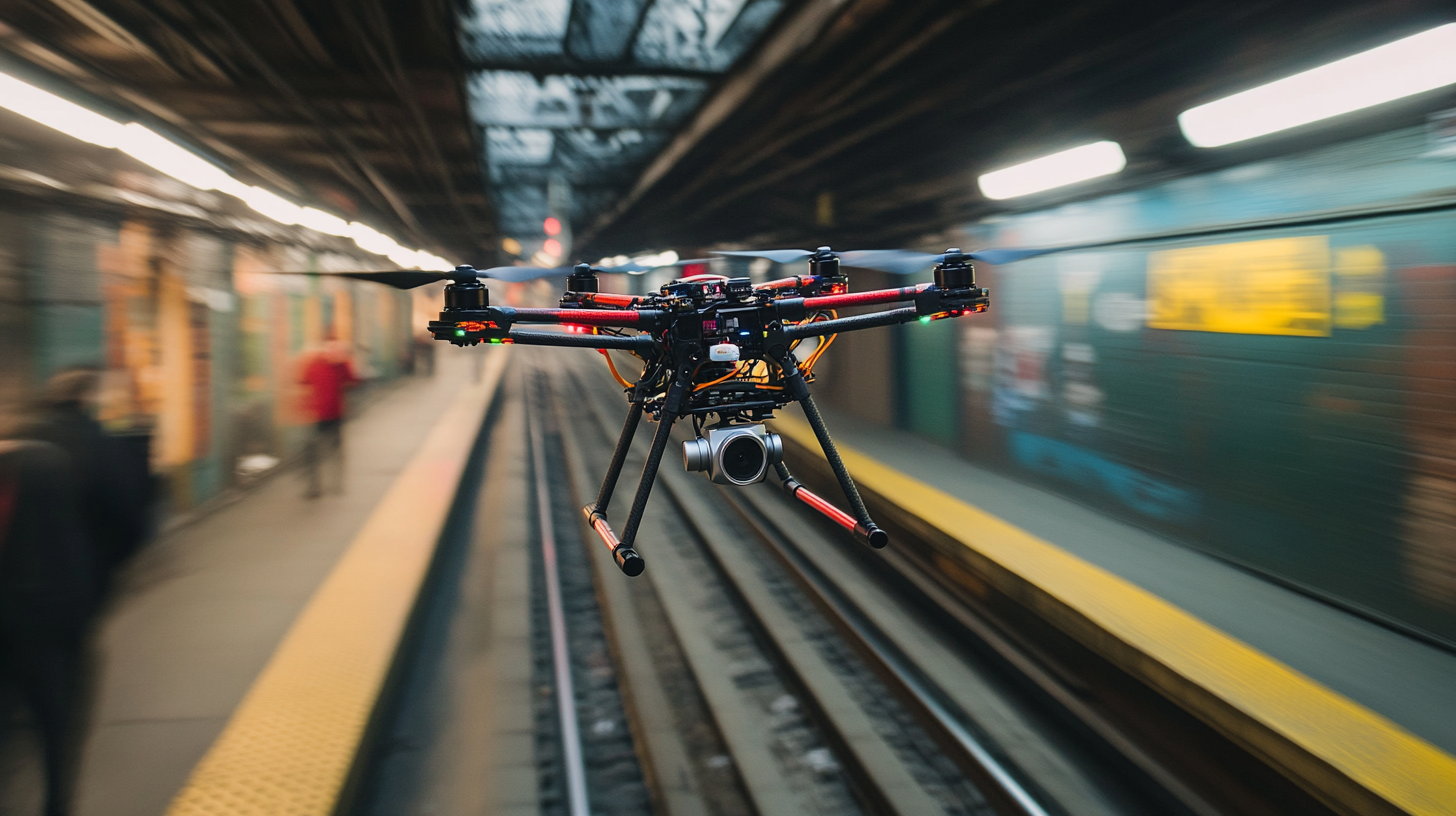

Efforts to increase surveillance with drones
In an effort to combat the rising trend of subway surfing, the city has turned to technology, specifically drones, to enhance surveillance across the subway system. These unmanned aerial vehicles are being deployed to monitor high-risk areas where young people are known to engage in the dangerous activity. By providing real-time footage, drones allow authorities to quickly identify and respond to incidents before they escalate, potentially saving lives.
The use of drones is seen as a proactive measure to deter individuals from attempting to surf on moving trains, a practice that has claimed the lives of three young New Yorkers in recent weeks. Officials believe that the presence of drones will not only act as a deterrent but also improve the ability to track and intervene in cases where individuals are spotted engaging in risky behaviour.
While some have raised concerns about privacy, city officials argue that the benefits of using drones for public safety far outweigh the drawbacks. The drones are primarily focused on monitoring public spaces within the subway system, and their use is strictly regulated to ensure they are not infringing on personal privacy. The goal is to create a safer environment for all commuters while preventing further tragedies.
Student-led public service announcements
In addition to technological measures, the city is also focusing on engaging young people directly through student-led public service announcements (PSAs). Recognizing that peer influence can be a powerful tool in shaping behaviour, officials have partnered with local schools and youth organizations to encourage students to create their own PSAs about the dangers of subway surfing. These announcements, which are being broadcast on social media platforms, in schools, and even within the subway system itself, aim to resonate with young audiences in a way that traditional messaging might not.
The idea behind this initiative is to give students a voice in the conversation, allowing them to communicate the risks of subway surfing in their own words and through their own creative lens. By involving young people in the process, the city hopes to foster a sense of ownership and responsibility among those most likely to be influenced by the trend. The PSAs range from short videos and animations to posters and digital art, all designed to capture attention and convey the serious consequences of engaging in such dangerous activities.
Many of the student-created PSAs have already gained traction online, with some going viral on platforms like TikTok and Instagram. These videos often feature stark imagery and emotional appeals, showing the devastating impact that subway surfing can have on families and communities. By leveraging the power of social media, the city is hoping to reach a wider audience and make the message more relatable to young people who might otherwise dismiss official warnings.
City officials have praised the creativity and passion shown by the students involved in the campaign, noting that their contributions are helping to shift the narrative around subway surfing. Rather than glorifying the activity as a thrill-seeking adventure, these PSAs emphasize the real-life dangers and the irreversible consequences that can result from a single misstep. The hope is that by hearing these messages from their peers, more young people will think twice before engaging in such risky behaviour.
Raising awareness to prevent future tragedies
Raising awareness about the dangers of subway surfing is crucial to preventing future tragedies, and the city is taking a multi-faceted approach to ensure the message reaches as many people as possible. Beyond the use of drones and student-led PSAs, officials are working closely with community leaders, schools, and local media outlets to amplify the conversation around this dangerous trend. The goal is to create a sustained dialogue that not only informs but also encourages young people to make safer choices.
One of the key strategies in this awareness campaign is to highlight the real-life stories of those affected by subway surfing accidents. Families who have lost loved ones are being invited to share their experiences in public forums, interviews, and community events. These personal accounts serve as a powerful reminder of the devastating consequences that can result from what might seem like a momentary thrill. By putting a human face to the issue, the city hopes to make the risks more tangible and relatable, especially for young people who may not fully grasp the potential dangers.
In addition to these personal stories, the city is also working to integrate subway surfing awareness into school curriculums. Teachers and counsellors are being provided with resources to discuss the issue in classrooms, with a focus on the psychological and social factors that might drive young people to engage in such risky behaviour. By addressing the root causes, such as peer pressure and the desire for social media fame, educators hope to equip students with the tools they need to resist these influences and make safer decisions.
Public service announcements and educational efforts are being complemented by a broader push to engage parents and guardians in the conversation. Workshops and informational sessions are being held in communities across the city, providing parents with the knowledge and resources to talk to their children about the dangers of subway surfing. These sessions emphasize the importance of open communication and encourage parents to be proactive in monitoring their children’s activities, particularly on social media, where subway surfing videos often gain traction.
Ultimately, the city’s approach to raising awareness is about creating a culture of safety and responsibility. By involving young people, families, educators, and the broader community, officials hope to foster an environment where subway surfing is no longer seen as an exciting challenge but as a dangerous and potentially deadly activity. The hope is that through continued education and outreach, future tragedies can be avoided, and young people will be empowered to make safer choices.
City initiatives to combat subway surfing
In response to the tragic deaths of three young New Yorkers over a six-week period, the city’s cracking down on subway surfing like a lifeguard on a crowded beach. The expanded plan? Well, it’s not just a slap on the wrist. They’re bringing in the big guns—drones. Yep, those little buzzing birds are now keeping an eye on the rails, making sure no one’s trying to catch a ride on top of a train like it’s a wave at Bondi.
But it’s not just about surveillance. The city’s also stepping up enforcement, with more patrols and fines for anyone caught in the act. It’s a bit like getting busted for fishing without a license—except this time, the stakes are a lot higher. The goal is to make sure no one else ends up in a tragic situation, thinking they’re invincible when they’re really just one slip away from disaster.
And while the drones are doing their thing, the city’s also pushing for more public service announcements to get the message out there. They’re hoping that with a bit of education and a lot of visibility, they can stop this dangerous trend before it claims any more lives.
Engaging youth in awareness campaigns
To really get the message across, the city’s not just relying on the usual talking heads. They’re bringing in the experts—students. Yep, the very same crowd that might be tempted to try subway surfing are now being asked to help create public service announcements. It’s a bit like asking a grommet to teach you how to wax your board—who better to know what’ll resonate with their mates?
The idea is simple: let the youth speak to the youth. These campaigns are designed to be raw, real, and relatable. No boring lectures or finger-wagging from some suit who’s never even seen a train roof, let alone surfed one. Instead, the city’s hoping that by giving students the reins, they’ll come up with something that actually sticks. Maybe a cheeky video or a meme that’ll go viral faster than a rip current.
And it’s not just about scaring kids off with horror stories. The goal is to show them that there are better ways to get their adrenaline fix. Whether it’s hitting the waves, shredding on a skateboard, or even just finding a safer way to push the limits, the message is clear: you don’t need to risk your life to have a good time. After all, there’s no point in catching the perfect wave if you’re not around to tell the tale.

